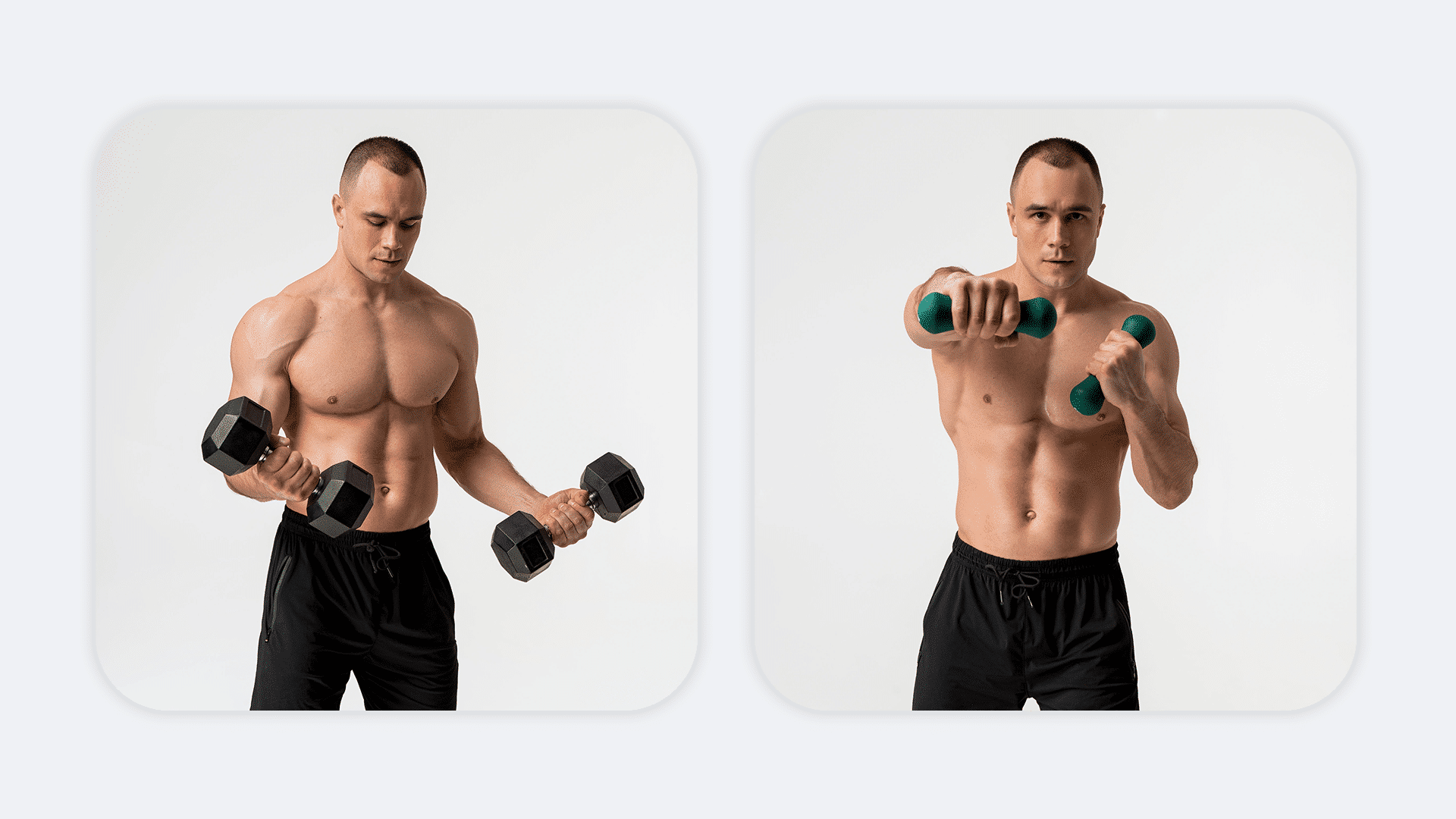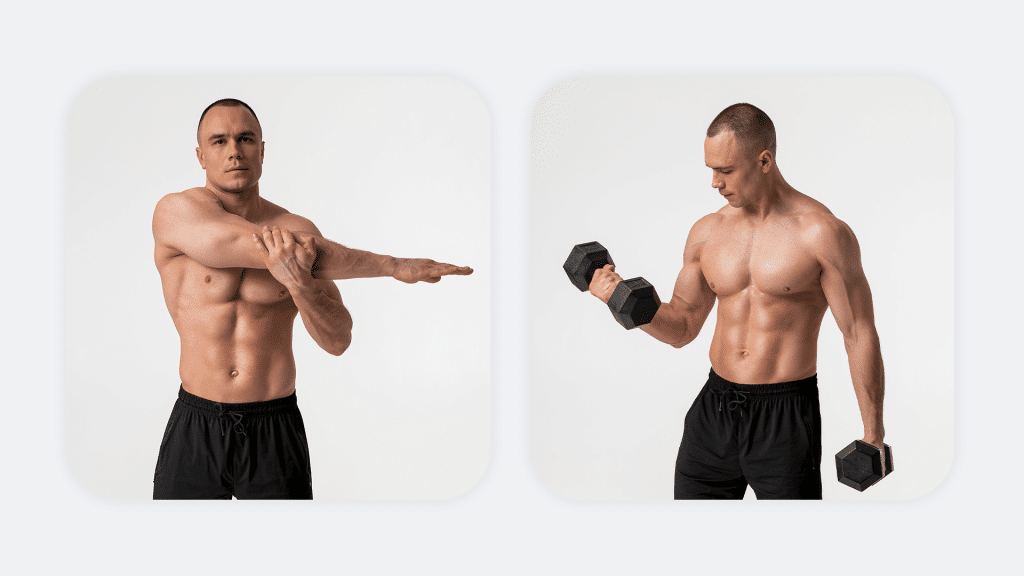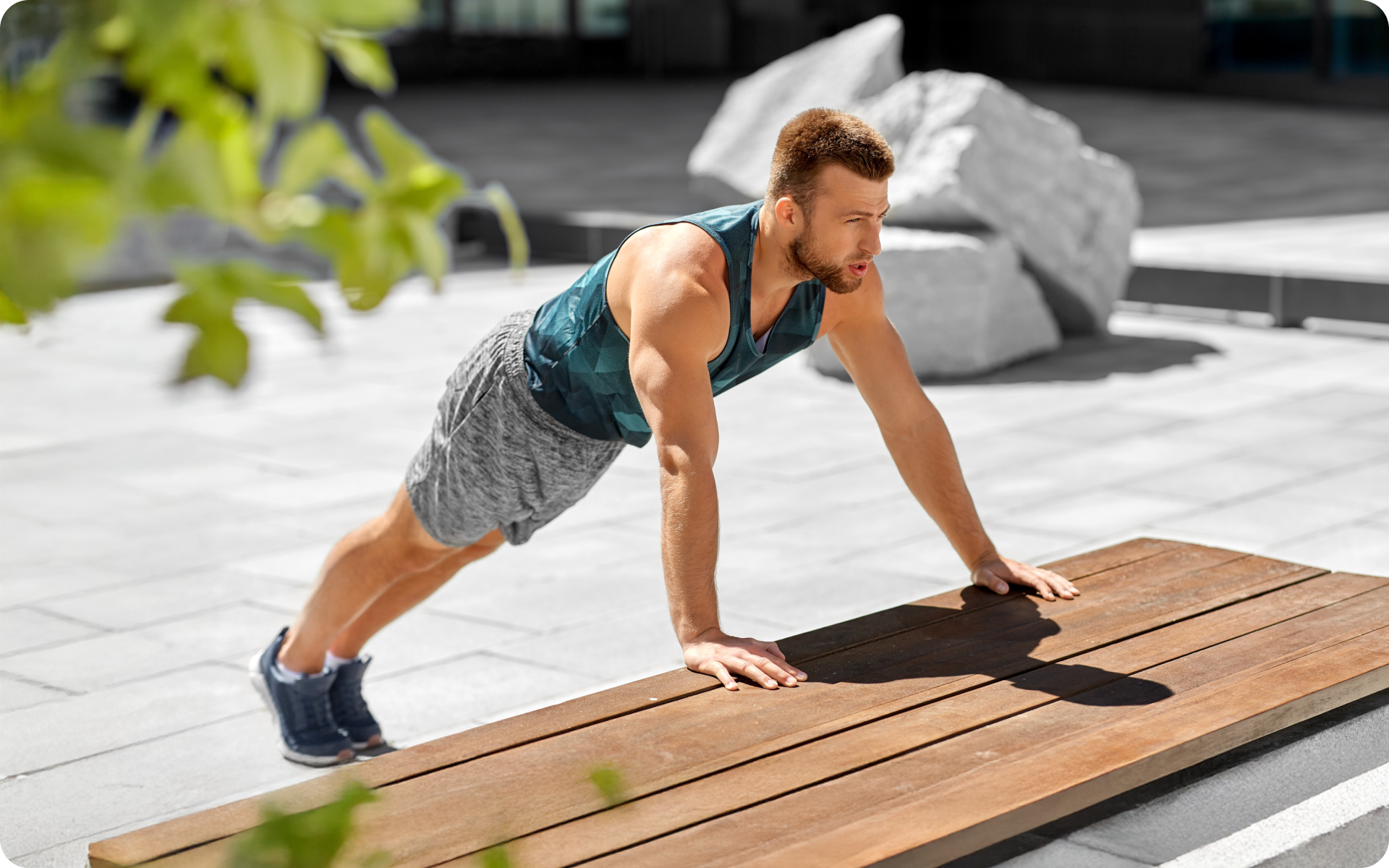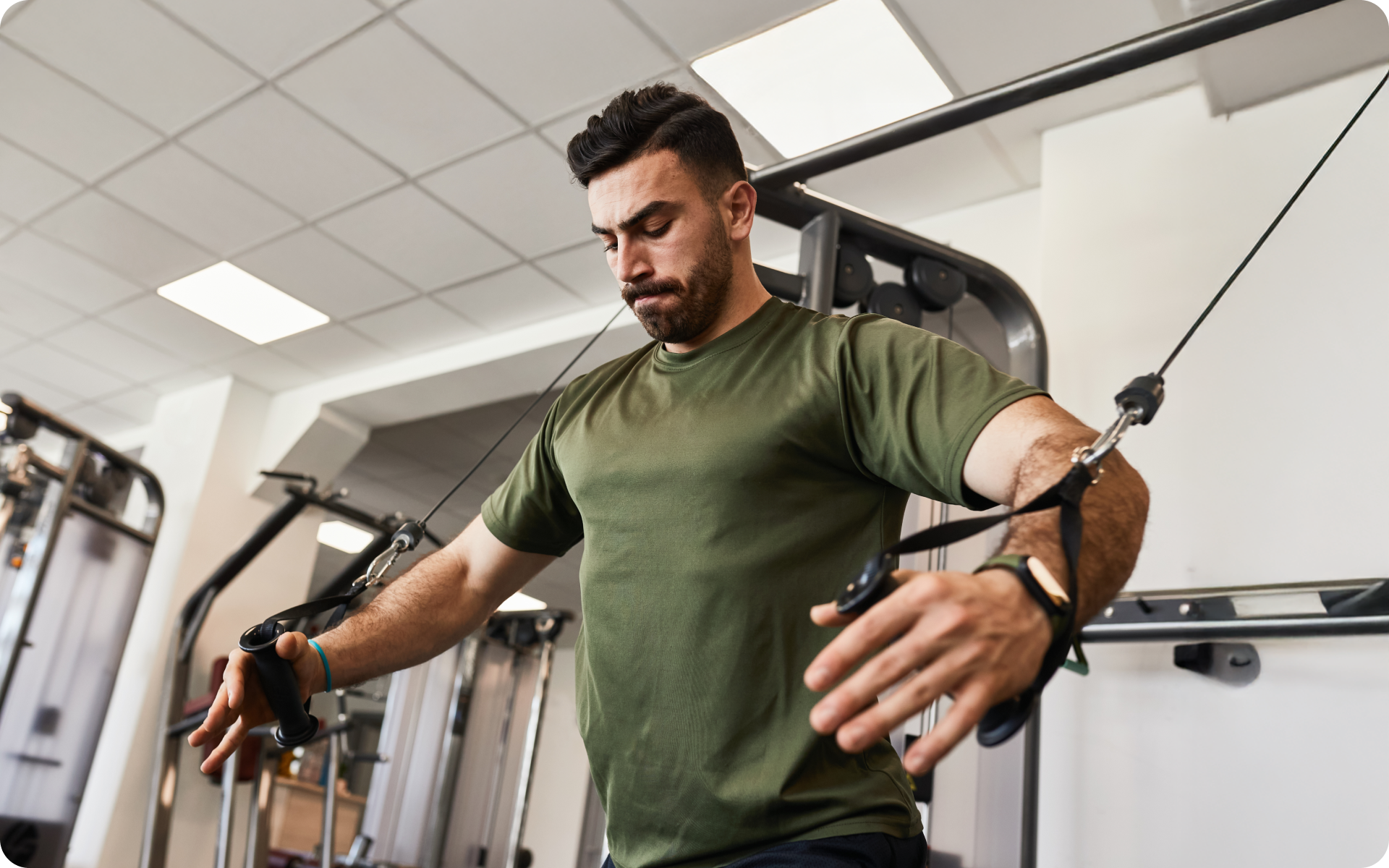Biceps are muscles that the majority of people want to show off. In a practical sense, they play a crucial role in daily activities, such as when lifting heavy objects or performing simple tasks such as opening jars. With the right training methods, you can target and strengthen your biceps effectively, regardless of where you are or what equipment you have at hand.
This is where calisthenics can come into play. This form of exercise uses body weight as resistance and can be done with minimal or no equipment. In this guide we will introduce you to five ingenious exercises that can be performed with or without bars, which will help you sculpt and strengthen your biceps using the principles of calisthenics.
Can You Build Biceps With Calisthenics?
Yes, you can build biceps with a calisthenics bicep workout, even without any equipment at all. By definition, calisthenics is a form of exercise that uses your body weight as resistance to develop your muscles (4), which includes your biceps. This means you are not limited to the confines of a gym or specialized equipment with this form of exercise. By leveraging your body weight you can effectively target and stimulate bicep growth, anywhere at any time.
Pull-ups and chin-ups are some of the most effective calisthenics exercises for bicep development (3). These exercises target the biceps, back, and shoulders, and promote overall upper-body strength. Pull-ups involve an overhand grip that slightly emphasizes your back, while chin-ups use an underhand grip and place more focus on the biceps.
Push-ups, which are typically known for targeting the chest and triceps, can also engage the biceps when they are performed with a diamond hand position. With this variation the hands are positioned close together under the chest and form a diamond shape. This small adjustment shifts the focus from the chest and triceps to the biceps and triceps.
It is important to remember that the key factor in muscle development is progressive overload – gradually increasing the stress that is placed upon the body during training (2). With calisthenics this can be achieved by increasing the intensity, adjusting the tempo, or altering the exercise variations.
If you’ve mustered up the courage to crush your weight loss goal, let Betterme take the sting out of this demanding process. Our app will help you restructure your habits, remold your life and crank up your fitness results!
How Do You Do Bicep Calisthenics Without Pull-Ups?
Sure, pull-ups are a fantastic exercise for working the biceps, but they’re not the only way you can build these muscles. Below are five bicep calisthenics exercises you can perform instead:
Reverse Grip Push-ups
A unique twist to the conventional push-up and a great addition to your calisthenics bicep workout routine with no equipment. Unlike regular push-ups that are more focused on the chest, this exercise specifically targets the biceps.
Step-by-step execution:
- Start by getting into a high plank position
- Rotate your hands 180 degrees so your fingers point toward your feet – this is what makes it reverse grip
- Engage your core and lower your body, keeping your back straight and your elbows close to your body
- Push your body up – remember your biceps should do the work
- Repeat this for the desired number of reps
One-arm Wall Push
This exercise falls under the calisthenics bicep workout beginner category as it is simple. The difficulty can be adjusted based on the distance you stand from the wall.
Step-by-step execution:
- Stand facing a wall with your feet hip-width apart
- Extend one arm and place your hand flat against the wall at chest height
- Lean into the wall, allowing your arm to bend as you get closer to it
- Push yourself back to the starting position using just your arm strength
- Repeat for the desired number of reps and switch arms
Isometric Towel Curl
This is a unique bicep and tricep calisthenics workout that uses a common home item, which makes it a perfect bicep exercise with no equipment.
Step-by-step execution:
- Stand upright with both hands in front of you, holding a towel that touches the floor
- Step on the middle of the towel with one foot
- Pull upward on the towel while resisting with your foot to create tension
- Hold this position for the desired amount of time
Diamond Push-ups
These are a staple in the best calisthenics bicep workout routines as they effectively target both the biceps and triceps.
Step-by-step execution:
- Assume a push-up position, but place your hands close together so your thumbs and index fingers touch and form a diamond shape
- Lower yourself down until your chest almost touches your hands
- Push back up to the starting position and repeat
Static Arm Curl
This is an excellent bodyweight bicep exercise and a great option for a beginner bicep workout with no equipment needed.
Step-by-step execution:
- Stand up straight and extend your arms in front of you at chest height
- Make a fist with your hands and engage your biceps as if you were lifting weights
- Hold this position for as long as you can
Do Push-ups Build Biceps?
Yes, push-ups can contribute to building biceps, but they are not the most effective exercise for this specific goal. Push-ups primarily target the chest, shoulders, and triceps, and the biceps act as a secondary muscle group.
With a standard push-up, the biceps are engaged in an isometric contraction, which contributes to muscle endurance and stability, but the exercise is unlikely to result in significant size increase or strength gains in the biceps. This is because the biceps do not go through a full range of motion and are not subjected to the kind of stress that stimulates growth.
However, there are push-up variations that can place more emphasis on the biceps. For example, reverse grip push-ups, where your fingers point toward your feet, engage the biceps more than traditional push-ups, and diamond push-ups, where your hands are close together directly under your chest, also require more work from the biceps.
So, while push-ups can form part of a routine that is aimed at building biceps, they should not be the sole focus. Incorporating other exercises that specifically target the biceps and allow for a full range of motion, such as curls or pull-ups, will yield far better results for bicep growth.
Read more: Plyometrics Vs Calisthenics: Which One Should Beginners Do?
How Do You Get Big Biceps With Calisthenics?
Getting big biceps with calisthenics involves a combination of effective exercises, consistency, and proper nutrition. Here are some steps you can take:
Choose the right exercises
Some of the most effective calisthenics exercises for biceps include chin-ups, commando pull-ups, one-arm chin-up negatives, headbangers, horizontal bodyweight ring curls, and inverted rows. These exercises target the biceps directly and help stimulate muscle growth.
After choosing your exercises, there are some specific strategies you can employ in a no equipment bicep workout that can potentially yield even better results for bicep growth:
- Advanced Exercise Variations: Instead of standard chin-ups and pull-ups, try advanced variations such as archer pull-ups or typewriter pull-ups. These exercises isolate one arm at a time, which provides an intense workout for your biceps.
- Grip Changes: Altering your grip can target different parts of your biceps. For example, a wider grip during pull-ups primarily works the short head of the biceps, whereas a narrower grip targets the long head more intensely.
- Tempo Manipulation: Slowing down the eccentric (lowering) phase of your exercises increases muscle tension and can stimulate more growth. Try a 1-2 second concentric (lifting) phase and a 3-4 second eccentric phase.
- Isometric Holds: Incorporate isometric holds in your training. Holding at the top position of a chin-up or at the midpoint of a body row can increase time under tension, which is a key factor for muscle hypertrophy.
- Volume Cycling: Instead of adding reps or sets, cycle your volume. Have weeks where you push hard (high volume), followed by lighter weeks (low volume) to allow for recovery and growth.
- Greasing the Groove (GTG): This technique involves performing multiple sets of an exercise throughout the day, but never to failure. This is a great way of improving your strength and muscle endurance without overtaxing your system.
By incorporating these unique strategies into your routine you will be well on your way to building bigger biceps with calisthenics.
Focus on form and control
When performing a calisthenics bicep workout either with or without a bar, it’s important to focus on maintaining good form and controlling your movements. This will help ensure your biceps are fully engaged during each exercise.
An ideal calisthenics bicep workout for beginners may involve slow, controlled reps and extended pauses at the top or bottom of each rep. The idea is to create a mind-body connection, which allows you to better feel the contraction in your biceps and maximize muscle activation.
Use progressive overload
To continue building muscle over time, your aim should be to gradually increase the difficulty of your bicep and tricep calisthenics workout (2). This can involve more reps or sets, increasing the intensity of your exercises, or incorporating more challenging variations of exercises into your routine. In addition, you could go from performing bodyweight bicep exercises to the use of resistance bands or weighted plates.
Recover and eat properly
Recovery and nutrition are also essential for muscle growth (1). You should make sure you get enough rest between workouts to allow your muscles time to recover and grow. This even applies to beginner bicep workouts with no equipment – adequate recovery is always essential. In addition, eating a balanced diet that is rich in nutrient-dense foods will provide your body and muscles with the right fuel for growth.
Yanking yourself back in shape has never been so easy with our game-changing fitness app! Start transforming your life with BetterMe!
Frequently Asked Questions
How can I get thicker biceps?
Thickening the biceps involves a combination of consistent strength training, proper nutrition, and adequate rest. You should incorporate exercises that target the biceps directly, such as curls, pull-ups, and certain push-up variations into your workout routine. Aim for 3-4 sets of 8-12 reps, which is typically ideal for muscle growth.
In addition, you should consume a balanced diet that is rich in protein to support muscle repair and growth. It is important to remember that muscles grow during rest periods, not while you’re working out, so you must make sure you get enough sleep and rest between workouts.
Can I train the biceps every day?
While it may be tempting to work your biceps every day to achieve faster results, this is not recommended. Your muscles require time to recover and grow following a workout. Overtraining can result in fatigue, decreased performance, or even injuries.
For optimal results, it is generally recommended to train your biceps 2-3 times per week, allowing at least 48 hours of rest between sessions to ensure your muscles have sufficient time to recover and grow.
Do biceps need a lot of reps?
The number of reps you should perform is dependent on your fitness goals. If you’re aiming for strength and size, fewer reps with heavier weights is recommended. However, if you’re focused on muscle endurance, you should perform more reps (around 15-20) with lighter weights.
For the majority of people, a range of 8-12 reps is a good general guideline for building muscle. You must remember that the key is to challenge your muscles. The last few reps should feel difficult, but still possible to complete if you maintain good form.
Read more: Setting Up a Daily Calisthenics Routine That Works: Exercises, Frequency, and More.
The Bottom Line
Incorporating calisthenics into your workout routine offers a versatile and effective way of building your biceps, whether you have access to bars or not. From innovative push-up variations to isometric exercises, the five ingenious exercises in this article can help you develop strong, well-defined biceps.
DISCLAIMER:
This article is intended for general informational purposes only and does not serve to address individual circumstances. It is not a substitute for professional advice or help and should not be relied on for making any kind of decision-making. Any action taken as a direct or indirect result of the information in this article is entirely at your own risk and is your sole responsibility.
BetterMe, its content staff, and its medical advisors accept no responsibility for inaccuracies, errors, misstatements, inconsistencies, or omissions and specifically disclaim any liability, loss or risk, personal, professional or otherwise, which may be incurred as a consequence, directly or indirectly, of the use and/or application of any content.
You should always seek the advice of your physician or other qualified health provider with any questions you may have regarding a medical condition or your specific situation. Never disregard professional medical advice or delay seeking it because of BetterMe content. If you suspect or think you may have a medical emergency, call your doctor.
SOURCES:
- Muscle Recovery and Nutrition (2022.nih.gov)
- Progression of volume load and muscular adaptation during resistance exercise (2014,nih.gov)
- Pull Ups: Benefits, Muscles Worked, and More (2023,inspireusafoundation.org)
- The advantages of body-weight exercise (2022,harvard.edu)











